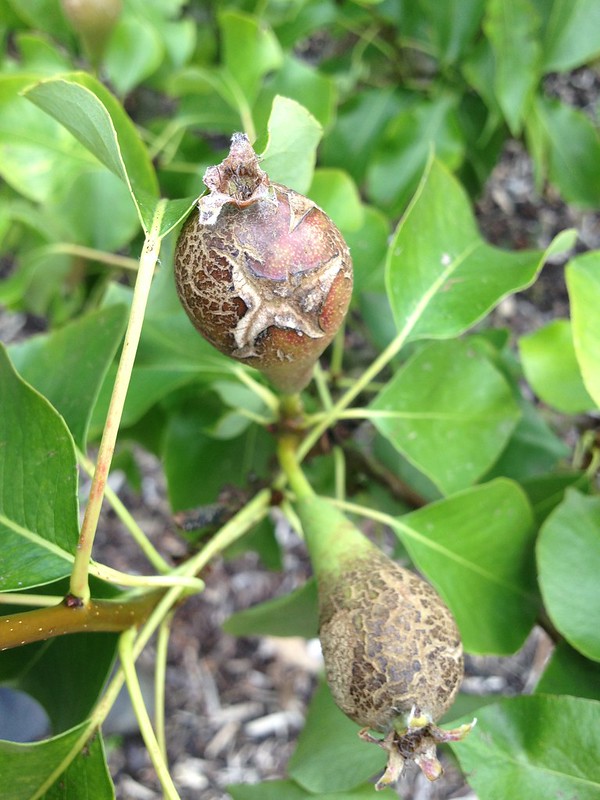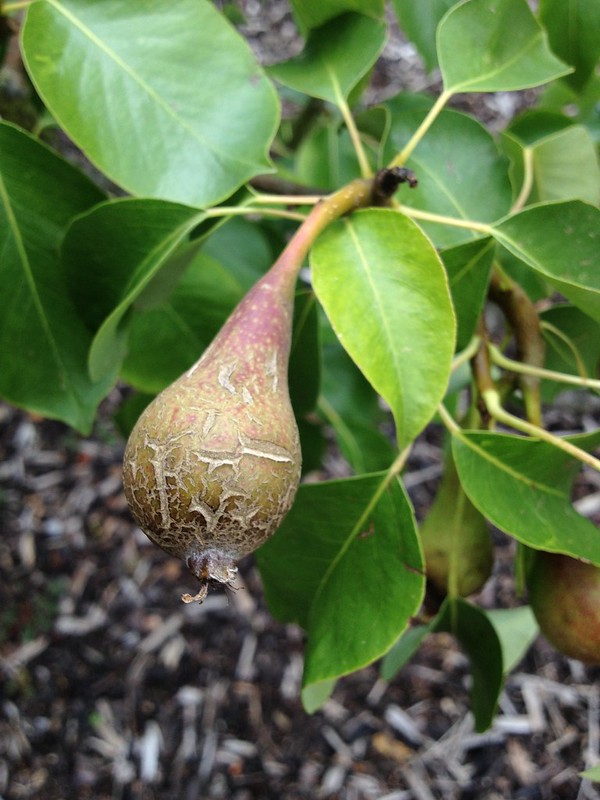We were however not required to study disorders, which are the third issue affecting plant health and as such are included in the acronym "PD&D" that you might have read somewhere, so I want to touch on them here. Disorders are physiological conditions in which the plant behaves abnormally in response to environmental conditions (i.e. nutrient deficiencies, drought, heat, physical damage etc.) - they are very difficult to identify, as this excellent guide from Michigan State University explains.
One such disorders I encountered at Wisley was on 'Conference' pears. In some years more than others, some pears develop corky lesions on their skin, maybe due to some nutrient deficiency and possibly facilitated by dry weather. These may on occasion be mistaken for fungal disease scab (Venturia pirina) but have been identified as a likely disorder. 'Conference' pears are particularly prone to them: not only did I received a good few questions from visitors that spotted it in the Fruit Garden, I had it on my tree at home. Dealing with it means simply removing the worst affected fruitlets, so that they do not take up the plant's energy, but keeping in mind that most fruits grow out of it to become happy pears.
 |  |
| Disorder, unspecified (badly affected fruitlets, left; mildly affected, right) | |
 |
| Pear scab (Venturia pirina) damage |
And here is the link to my project:
together with the table of contents:
Fruit
Apple (Malus domestica) and pear (Pyrus communis)
Brown rot of apple and pears (Monilinia fructigena, M. laxa)
Apple and pear canker (Neonectria galligena)
Apple powdery mildew (Podosphaera leucotricha)
Rosy apple aphid (Dysaphis plantaginea)
Codling moth (Cydia pomonella)
Apple and pear scab (Venturia inaequalis, V. pirina)
Blackcurrant (Ribes nigrum)
Big bud mite (Cecidophyopsis ribis)
Gooseberries (Ribes uva-crispa)
Gooseberry sawfly (Nematus ribesii)
Grapes (Vitis spp)
Grey mould (Botrytis cinerea)
Raspberry (Rubus idaeus)
Raspberry beetle (Byturus tomentosus)
Cane blight (Leptosphaeria coniothyrium)
Vegetables
Cabbage (Brassica oleracea)
Cabbage root fly (Delia radicum)
Mealy cabbage aphid (Brevicoryne brassicae)
Leek (Allium porrum)
Leek rust (Puccinia allii)
Pea (Pisum sativum)
Wood pigeons (Columba palumbus)
together with the table of contents:
Fruit
Apple (Malus domestica) and pear (Pyrus communis)
Brown rot of apple and pears (Monilinia fructigena, M. laxa)
Apple and pear canker (Neonectria galligena)
Apple powdery mildew (Podosphaera leucotricha)
Rosy apple aphid (Dysaphis plantaginea)
Codling moth (Cydia pomonella)
Apple and pear scab (Venturia inaequalis, V. pirina)
Blackcurrant (Ribes nigrum)
Big bud mite (Cecidophyopsis ribis)
Gooseberries (Ribes uva-crispa)
Gooseberry sawfly (Nematus ribesii)
Grapes (Vitis spp)
Grey mould (Botrytis cinerea)
Raspberry (Rubus idaeus)
Raspberry beetle (Byturus tomentosus)
Cane blight (Leptosphaeria coniothyrium)
Vegetables
Cabbage (Brassica oleracea)
Cabbage root fly (Delia radicum)
Mealy cabbage aphid (Brevicoryne brassicae)
Leek (Allium porrum)
Leek rust (Puccinia allii)
Pea (Pisum sativum)
Wood pigeons (Columba palumbus)
No comments:
Post a Comment